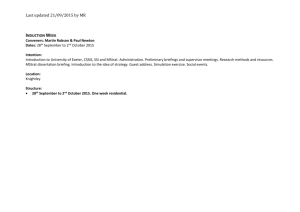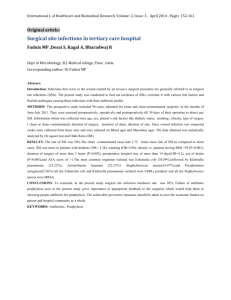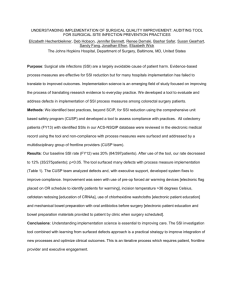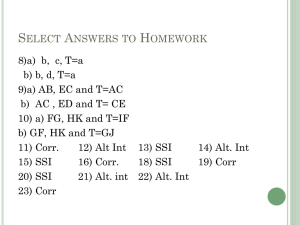Document - digidyna.com
advertisement
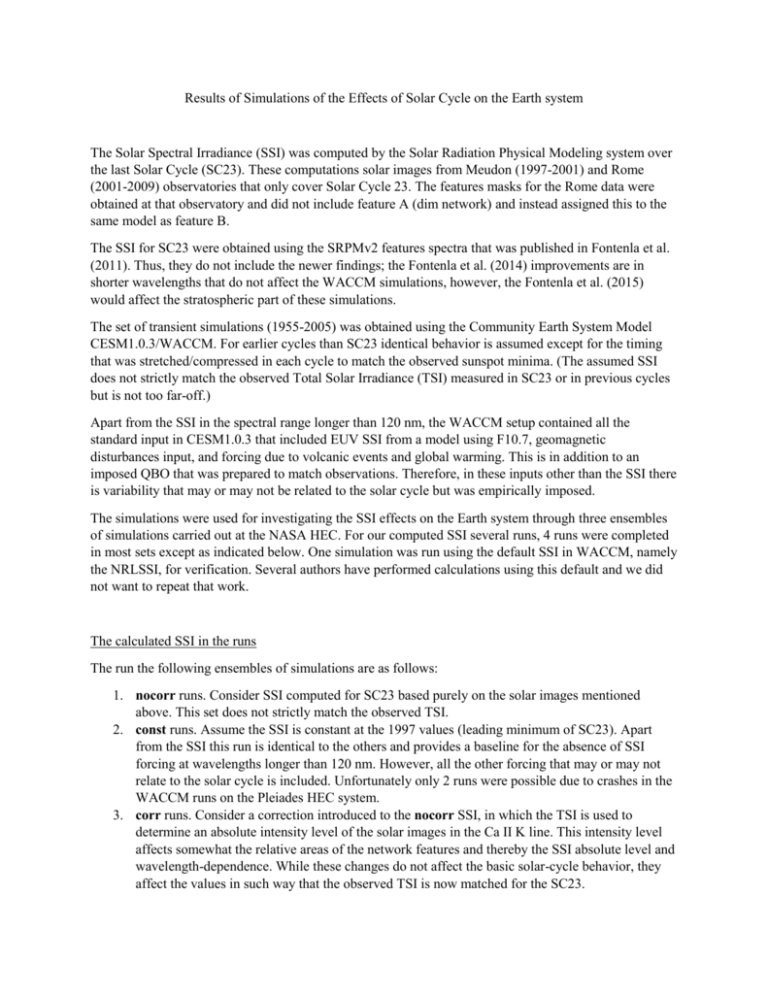
Results of Simulations of the Effects of Solar Cycle on the Earth system The Solar Spectral Irradiance (SSI) was computed by the Solar Radiation Physical Modeling system over the last Solar Cycle (SC23). These computations solar images from Meudon (1997-2001) and Rome (2001-2009) observatories that only cover Solar Cycle 23. The features masks for the Rome data were obtained at that observatory and did not include feature A (dim network) and instead assigned this to the same model as feature B. The SSI for SC23 were obtained using the SRPMv2 features spectra that was published in Fontenla et al. (2011). Thus, they do not include the newer findings; the Fontenla et al. (2014) improvements are in shorter wavelengths that do not affect the WACCM simulations, however, the Fontenla et al. (2015) would affect the stratospheric part of these simulations. The set of transient simulations (1955-2005) was obtained using the Community Earth System Model CESM1.0.3/WACCM. For earlier cycles than SC23 identical behavior is assumed except for the timing that was stretched/compressed in each cycle to match the observed sunspot minima. (The assumed SSI does not strictly match the observed Total Solar Irradiance (TSI) measured in SC23 or in previous cycles but is not too far-off.) Apart from the SSI in the spectral range longer than 120 nm, the WACCM setup contained all the standard input in CESM1.0.3 that included EUV SSI from a model using F10.7, geomagnetic disturbances input, and forcing due to volcanic events and global warming. This is in addition to an imposed QBO that was prepared to match observations. Therefore, in these inputs other than the SSI there is variability that may or may not be related to the solar cycle but was empirically imposed. The simulations were used for investigating the SSI effects on the Earth system through three ensembles of simulations carried out at the NASA HEC. For our computed SSI several runs, 4 runs were completed in most sets except as indicated below. One simulation was run using the default SSI in WACCM, namely the NRLSSI, for verification. Several authors have performed calculations using this default and we did not want to repeat that work. The calculated SSI in the runs The run the following ensembles of simulations are as follows: 1. nocorr runs. Consider SSI computed for SC23 based purely on the solar images mentioned above. This set does not strictly match the observed TSI. 2. const runs. Assume the SSI is constant at the 1997 values (leading minimum of SC23). Apart from the SSI this run is identical to the others and provides a baseline for the absence of SSI forcing at wavelengths longer than 120 nm. However, all the other forcing that may or may not relate to the solar cycle is included. Unfortunately only 2 runs were possible due to crashes in the WACCM runs on the Pleiades HEC system. 3. corr runs. Consider a correction introduced to the nocorr SSI, in which the TSI is used to determine an absolute intensity level of the solar images in the Ca II K line. This intensity level affects somewhat the relative areas of the network features and thereby the SSI absolute level and wavelength-dependence. While these changes do not affect the basic solar-cycle behavior, they affect the values in such way that the observed TSI is now matched for the SC23. Figure 1 shows the comparison of the nocorr SSI compared with WACCM default NRLSSI at several key wavelengths and for the time of SC23 maximum. This shows that at Ly alpha there is only a small offset but similar behavior; in the NUV our computed SSI is substantially larger than NRLSSI; in the visible and IR our SSI varies little and this variation has opposite sign to the NRLSSI variation; in the farIR again our SSI varies similarly to the NRLSSI. Thus, the differences in the SSI variations behavior occur in the NUV, visible, and IR. Fig. 1. Comparison of the nocorr SSI with WACCM default NRLSSI. Figure 2 shows a comparison of the NUV relative variation over the solar cycle, as function of wavelength, for our nocorr and corr cases. This figure shows that longer of ~210 nm, the nocorr and NRLSSI relative variations are not dissimilar but our computations variations were larger. It also shows that our computations display SSI variations, at ~240 and ~260 nm and also at some other specific wavelengths, that much larger than the corresponding in NRLSSI. We identify these spikes in our SSI variations as a result if the Fe II and other strong and deep spectral lines. Also, we identify the source of our relatively small variability at wavelengths shorter than ~210 nm with the too high SSI level in our calculations for the wavelength range ~160-~210 nm that was mentioned in Fontenla et al. (2011 and 2014) and was solved in Fontenla et al. (2015) after the simulations discussed here. Note that the corr SSI has much larger variations across the entire range. nocorr corr nrl delta.Flux/Flux_min (%/100 F10.7 units) 8 6 4 2 0 180 200 220 240 260 280 300 320 340 360 380 400 Wavelength (nm) Fig. 2. Comparison of the NUV SSI in nocorr and corr with WACCM default NRLSSI. Fig. 3. Timing of the cycles in the simulations and selected years for making differences between sola max and min. The computed tropospheric surface effects of the solar cycle SSI variations For evaluating these we averaged each ensemble results, and used the single run result for NRLSSI. From these we selected the min solar activity times, and the max solar activity times (as shown in Fig. 3) in all the WACCM results. Then, we made the difference between the average of the max and the average of the min results. A sample of the most important surface results we examined is shown in Figure 4 where the data corresponds to the average of these differences for the North hemisphere winter months (Dec, Jan, Feb). Fig. 4. The average of the max minus the average of the min solar activity for some quantities at the Earth’s surface. Top row, total cloud coverage (fraction); middle row, surface temperature (K); bottom row, surface pressure (hPa). Shaded areas correspond to differences that are insignificant (at the 2 sigma level) with respect to the fluctuations between members of the ensemble. The results shown in Fig. 4 as maps may seem to suggest some patterns but it should be considered that the ensembles have few members and more would be necessary to definitively assert such patterns. Moreover, we find the cooling of the western Pacific Ocean near the equation, shown in the second row, and some apparent changes in the cloud cover, first row, can be due to forcing other than SSI because examining the time series of temperatures and aerosols we find that the years and regions where this cooling appears correspond higher aerosol values that are expected to produce cooler temperatures and that correspond to well-known volcanic eruptions that produced the aerosols in the WACCM simulation. Therefore, we do not find a definitive result on the solar cycle influence in the surface temperature because it rather seems it is the volcanic aerosols that produce the cooling of the Western Pacific Ocean. Whether an additional solar influence exists cannot be determined from these simulations. Some patterns are also apparent in the total cloud cover around the tropics over the tropical Pacific and Indian oceans. And these seem to reflect also on the sea level temperature, although is not clear whether they may be produced by other inputs than the SSI it is interesting that they do not exist in the const SSI case. Still the isolated fluctuations indicate that to get more significant results many more runs are needed on each ensemble, and that is beyond the current project. More apparent results are shown by Fig. 4 last row, on the surface pressures. It seems clear on these that the average sea level pressure is enhanced in the region of the Pacific Ocean just south of Alaska and in the Aleutian Islands at times of solar max. Also, some other details, e.g. Jetstream location, are related to this issue. Also, the corr SSI case, not shown in this figure, presents the same feature that is only absent in the const SSI case. Tracking down the detail we find that the monthly average sea level pressure in that region fluctuates during the year and reaches minimum during the winter month (Dec, Jan, and Feb). Close examination shows that those minima are more pronounced at min solar activity, and the lack of too low presusres results in an elevated mean for solar max years. The maximum pressure in the summer months do not seem sensitive to the solar cycle, but when averaging over the year the bet result seems to be a higher pressure on the solar max activity years. These type of effects have actually been reported from observations. Still, the other issues of volcanoes, arbitrary QBO forcing, etc. remain and is not possible to make a definitive statement about these simulations demonstrating that this is a solar cycle effect without doubt. However, it is certainly a point that should be explored in other studies. A puzzling feature in Fig. 4 is the four spots of increased sea level pressure, but not as much as the mentioned above, around Antarctica. These are not present in the nocorr SSI case and are stronger in the nrlssi case. We doubt that they have much significance because these two cases have few ensemble members and particularly the nrlssi consists of a single run and shows the strongest and most localized four areas of high pressure, while nocorr that consists of four runs shows insignificant results in these areas. This behavior with the number of runs in each case is very different from the high average pressure in the region of the Aleutian Islands described above, in which increasing number of runs does not dilute the significance of the high sea level pressure. The computed extended atmospheric effects of the solar cycle SSI variations The effects of SSI on the stratosphere and above seem much more evident and dependent on the adopted SSI. However, still, the other issues of volcanoes, arbitrary QBO forcing, etc. remain and is not possible to make a definitive statement about these simulations demonstrating which the solar cycle SSI effects are without doubt. Figure 5 shows the zonal means maps of the differences between max and min of the mixing ratios of ozone and water vapor, on average during the norther hemisphere winter months (Dec., Jan, Feb.). The panel for O3 with const SSI already shows some differences especially at high altitudes that are driven by the parameters we did not control, as was described earlier. All cases with variable SSI show similar patterns at high altitude, but the behavior of the zonal means show dependency with the SSI case and important differences with the NRLSSI at pressure around 10 hPa for ozone and near ground level for water vapor (but recall we only did one simulation with NRLSSI). Fig. 5. Zonal means maps of O3 and H2O mixing ratio differences between max and min for the various SSI cases considered. Figure 6 shows the zonal means maps of the temperatures differences between max and min solar activity. Again, the const SSI case shows variations at high altitude that are driven by the parameters we did not control, as was described earlier. Again at high altitudes all SSI cases look very similar, probably because the heating is driven by wavelengths shorter than ~160 nm which are about the same in all cases. However, differences appear at pressures larger than 0.1 h Pa and the nocorr case is qualitatively similar to the const case, the corr case shows larger heating near the poles for pressures above 0.01 h Pa and near the equator increased cooling at pressure about 0.4 h Pa and heating at pressure around 40 h Pa. The NRLSSI case shows a patter similar but weaker than the nocorr case (but recall we only did one simulation with NRLSSI). Figures 5 and 6 demonstrate that the atmosphere is sensitive to the SSI case, and that the natural variations above the boundary layer are not much larger than the SSI effects. However, these figures also show that the const SSI case is not a good control case because it has embedded solar cycle variations that are not caused by the SSI at wavelengths longer than 120 nm that we controlled in the simulations. Fig. 6. Zonal means maps of the temperature differences between max and min for the various SSI cases considered. Summary After constructing the SSI for SC23 and producing a number of runs with CESM1.0.3/WACCM for the period 1955-2005 I conclude that, in the troposphere, the effects of the SSI variations over the solar cycle do not stand well above the natural variations or other forcing that occurred in that period. Any effects of solar variations of SSI at wavelengths longer than 120 nm are smaller or comparable to the natural variations and volcanic forcing, or QBO forcing. The only possible exception to this is the sea level pressure in the region south of Alaska and the Aleutian islands where it seems plausible that such pressure drop in the winter months is less pronounced at times of solar max. This pattern could be related to the near-UV SSI variations because it changes in intensity for the various near-UV SSI changes in our runs with nocorr, corr, and nrlssi, and is absent in our runs with const SSI. This seal level pressure effect has been observed, however, many more simulations would be necessary to prove this effect without any doubt. Solar cycle effects on the stratosphere are likely because they can be mediated by ozone formation, dissociation, and heating. The UV SSI affects these atmospheric processes, and our simulations show a large sensitivity to the solar cycle, but also show solar cycle sensitivity even in the const SSI case. In order to isolate the response of the Earth’s system to the SSI alone: 1) the QBO forcing would need to be eliminated and replaces by cases of constant Easterly and Westerly winds because, as shown by Labritzke and van Loon, such has a dependency on the solar cycle that affects the simulation results even if the SSI is maintained constant; 2) other forcing due to wavelengths shorter than 120 nm would have to be made consistent with the SSI shorter than that and be controlled to be able to make it constant in the control case; 3) the particle and magnetic forcing should be made constant to avoid contaminating the results with forcing other than the SSI. All these matters are rather complicated in the CESM1.0.3/WACCM and would require to change a number of NETCDF files in certain ways that are not clear to me. A much simpler approach would be to just run CAM5 simulations with and without solar cycle SSI and imposing Easterly and Westerly stratospheric winds, while any other forcing is maintained constant. Such simulations would be much faster and simpler than the full WACCM simulation. Results from such simulations can isolate the SSI driven variability and therefore prove some influence of the solar cycle on the processes that control the stratosphere and possible on downward propagation of such effects. However, results from these could not be directly comparable with observations that are sensitive to the other forcing.



